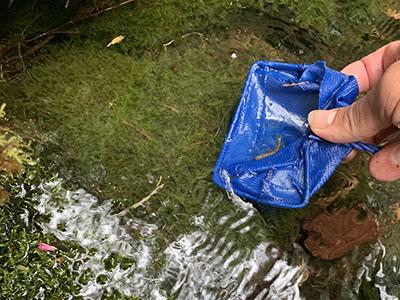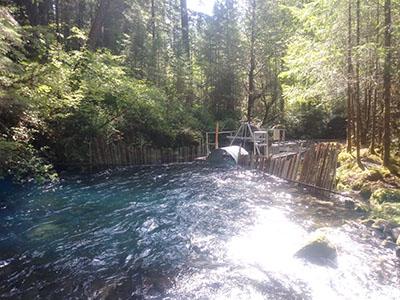Upper Willamette Bull Trout
Upper Willamette Bull Trout Research, Monitoring, and Conservation
Bull Trout historically occupied the McKenzie River and Middle Fork Willamette River basins within the Upper Willamette Basin. By the 1990s, only three spawning populations remained in this area, all in the McKenzie. In response to this decline, management agencies initiated programs to improve habitat, ameliorate threats, and reintroduce Bull Trout to formerly occupied habitat. The Upper Willamette Bull Trout monitoring project supports these efforts with a variety of activities, such as active management, research, and monitoring. Management actions implemented by this project include the capture and upstream transport of adult Bull Trout downstream of Hills Creek Dam, transport upstream for adult Bull Trout collected at the Cougar Dam fish passage facility, and the translocation of juvenile Bull Trout from source populations (e.g., Roaring River) to reintroduction target areas (e.g., Indigo Creek). Research and monitoring activities include assessing the status of populations of Bull Trout in the Middle Fork Willamette and McKenzie basins, including population abundance, demographic characteristics, recruitment, and spawning; assessing population connectivity and movement patterns across life stages through the operation of screw traps, PIT antennas, and other sampling protocols; facilitating sample collection for genetic analysis; and assessing the suitability of habitat at potential reintroduction sites.
For More Information
Project Contact: Nik Zymonas
Recent Reports:
- Zymonas, ND, MJ Hogansen, MP Scheu, JV Tranquilli, and AS Harrison. 2021. Bull Trout research and monitoring in the Upper Willamette Basin 2010-2017. ODFW Progress Reports.
- Zymonas, ND, JV Tranquilli, MJ Hogansen, MP Scheu, and AS Harrison. 2021. Bull Trout research and monitoring in the upper Willamette Basin, 2018–2020. Science Bulletin 2021-11. Oregon Department of Fish and Wildlife, Salem.
- Zymonas, ND, JV Tranquilli, MJ Hogansen, MP Scheu, and AS Harrison. 2022. Bull Trout research and monitoring in the upper Willamette Basin, 2021. ODFW Progress Report.

Spawning Surveys
The Upper Willamette Bull Trout Project conducts spawning ground surveys throughout upper Willamette and McKenzie basin tributaries each autumn.

Night Snorkeling In The Upper Willamette
We conduct night-snorkeling surveys to assess abundance of juvenile Bull Trout in key stream reaches. Juvenile Bull Trout are typically concealed by cover during the day but emerge at night.

Bull Trout Reintroductions
Reintroduction efforts have been a core component of Bull Trout management in the Upper Willamette since 1993. Recent efforts have focused primarily on collection and translocation of recently emerged young-of-the-year Bull Trout into headwaters sites with appropriate habitat characteristics.

Installing A Floating Weir
Project staff completed the installation of a floating weir to enable trapping and underwater video monitoring of fish in the Hill Creek Dam tailrace in an effort to provide upstream passage of adult Bull Trout toward headwater spawning reaches.

Rotary Screw Trapping
The rotary screw trap is a useful device that funnels downstream-migrating Bull Trout and other fish into a live box. Biologists can then tag the fish with Passive Integrated Transponders (PIT) tags, which enable tracking of movement past detection stations and identification of individual fish when subsequently recaptured.

Salvaging Fish In The Leaburg Canal
Occasionally, we conduct direct efforts to minimize mortality to Bull Trout where diversions or construction projects at dams may trap fish in isolated areas. This photo shows ODFW biologists using seine nets to collect fish in the Leaburg Canal. All recovered Bull Trout were returned to the McKenzie River after being PIT-tagged to facilitate the monitoring of subsequent movements.
